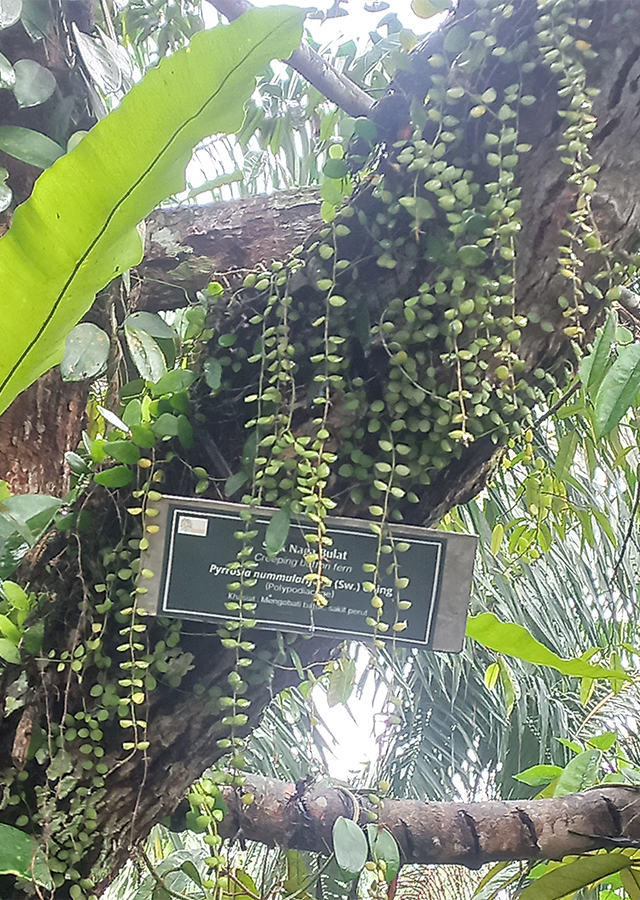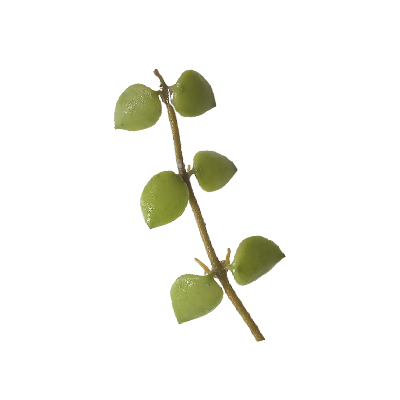Creeping Button Fern
Pyrrosia nummularifolia (Sw.) Ching
Polypodiaceae
Location in our garden
Principal



Synonym
Cyclophorus nummulariifolius (Sw.) C.Chr.
Cyclophorus obovatus (Blume) Alderw.
Galeoglossa nummulariifolia C.Presl
Habitus
Fern. An epiphytic, perennial, and long creeping fern.
Part Used
Leaves
Growing Requirements
Need Shade
Habitat
Forest
Roadside
Overview
Pyrrosia nummularifolia, its native range is India, Myanmar, the Philippines, Sulawesi (Indonesia), Lesser Sunda Islands. The genus Pyrrosia is derived from a Greek word, pyrrho meaning reddish; while the species epithet comes from two Latin words, nummularis referring to trade in coins and folium mean fronds, the combination of these two Latin words refer to the coin-shaped sterile fronds.
Vernacular Names
Paku berenas jantan (Malaysia), Qian bi shi wei (Chinese).
Agroecology
This slow grow fern occurs in limestone forests, lowland forests and in exposed sites, with an altitudes of 400-1100 m. As an epiphyte, it often grows in the crown of trees. It does well in moderate, indirect light and high humidity. Moist soil and moist but not wet sphagnum moss are helpful for rooting this species.
Morphology
- Rhizome - long creeping rhizome, filiform or wiry, 0.6-1.6 mm thick. Scales up to 5.7 mm long, brown, margin ciliate in the upper part.
- Leaves - green, dimorphic; sterile leaves sessile or with petioles up to 2.5 cm, lamina round to elliptical, 0.8-5 cm × 0.6-2 cm; fertile leaves with petiole up to 2.5 mm long, lamina elliptical to linear, 1.5-12.5 cm × 0.3-1 cm; stellate hairs dimorphic, hairs with mainly straight, acicular rays separated from a dense layer of hairs with mainly crisped rays, together forming a thick cover especially on the undersides of the leaves.
- Sori - round, 1-1.5 mm across, mostly hidden in the stellate hairs, superficial, without central bundle of paraphyses. Sporangia with stalks 1-1.5 × as long as capsule.
Cultivation
Generatively propagated by spores, and vegetatively by cutting and layering.
Chemical Constituents
Flavonoids, saponins, tannin, steroid.
Traditional Medicinal Uses
It is used in the treatment of cough, stomachache, sprue, and gingivitis.
Part Used
Reference Sources
- Flora of China. (No date). Pyrrosia nummulariifolia. http://www.efloras.org/florataxon.aspx?flora_id=2&taxon_id=242342432. 24-03-2022.
- Hovenkamp, P.H. (2016). Pyrrosia (PROSEA). https://uses.plantnet-project.org/en/Pyrrosia_(PROSEA). 24-03-2022.
- MyBIS (2022). Malaysia Biodiversity Information System: Pyrrosia nummulariifolia. https://www.mybis.gov.my/sp/55246. 24-03-2022.
- National Park of Singapore. (2022). Flora & Fauna Web: Pyrrosia nummularifolia. https://www.nparks.gov.sg/florafaunaweb/flora/5/8/5853. 24-03-2022.

